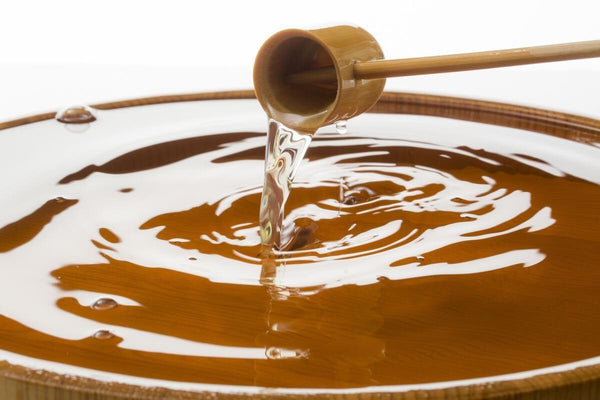
Jump to:
You may already know that mirin and rice vinegar are two staple pantry items when it comes to Japanese cuisine and can be purchased in grocery stores across Japan and found in practically every Japanese kitchen. However, many people don’t know the difference between these two products and how to use them.
In this article, we’ll discuss the main differences between mirin and rice vinegar, introduce the ingredients, explain what each product is used for, how to store them, and recommend some of the best authentic Japanese rice vinegar and mirin products that you can order online.
What are the main differences between rice vinegar and mirin?

There are several important differences between rice vinegar and mirin to be aware of. Firstly, the taste of these two products is very different. Mirin is a type of rice wine and has a much sweeter taste than rice vinegar. Rice vinegar is more bitter thanks to the natural sugar that forms in mirin during the fermentation process.
Secondly, the ingredients are different too. Whilst both contain fermented rice, water, and salt, mirin also contains shochu or brewed alcohol and has an alcohol content of about 14%.
Mirin is light brown in color and has quite a noticeable alcoholic scent and tastes similar to a sweet marsala wine. The flavor is mildly sweet, but not as strong as sugar. Japanese rice vinegar is mild and mellow tasting and is usually colorless or pale yellow.
Let’s look at each product in more detail to understand the different uses for each one, starting with mirin.
What is Mirin Made from and What Are the Different Kinds?

Mirin is a sweet rice wine made from glutinous rice, rice malt, shochu, or brewed alcohol, and sugar in a fermentation process that takes between 40 and 60 days. During the fermentation process, koji mold breaks down the starch in the glutinous rice into sugar and the protein into amino acids, giving it its unique sweetness and scent. This kind of mirin that contains shochu is also known in Japanese as hon mirin (true mirin in English), whilst other mirin products usually contain sake instead of shochu.
Hon mirin has no sugar or salt added and is usually more expensive than other types of mirin because it is a premium product. Try using hon-mirin if you want to create a high-quality sauce, glaze, or sushi rice.
Mirin-Style Seasonings
Aji-mirin or mirin-type condiment as it is also known has a lower alcohol content (around 8%) than hon-mirin and is a less expensive product. It usually contains an added sweetener, unlike hon-mirin whose sweetness comes from the natural fermentation process.
Mirin-fu is also known as a mirin-like condiment and usually contains less than 1% alcohol and salt. It is usually the cheapest kind of mirin you can buy and mimics the taste of hon-mirin using ingredients such as vinegar, corn syrup, rice seasoning, and other acidic flavorings.
How Did Mirin Become Popular in Japanese Cooking?

Mirin is used as a seasoning today, but hundreds of years ago during Japan’s Sengoku Period (1467-1615), it was consumed as a sweet alcoholic beverage.
Mirin came to be used as a seasoning in eel sauce and soba sauce in the late Edo period (1603-1868). Gradually, some ordinary households began to use mirin as a seasoning, but it was still considered a luxury item.
By the 1950s, it became cheaper to purchase thanks to government tax cuts and grew in popularity among ordinary households to become one of Japan's key ingredients in cooking.
When do we use Mirin in Cooking?

To add depth and umami flavor to dishes – you can use mirin in your cooking when you want to add depth of flavor to your dish to give your food an additional umami taste. Ingredients such as amino acids and peptides produced by the glutinous rice and sugars intertwine to create a deep richness and umami flavor.
To add a gentle sweetness to dishes – mirin's sweetness comes from the natural sugars formed during its fermentation process, based on several types of sugars such as glucose and oligosaccharide. This type of sugar provides a mild and gentle sweetness, effective in a wide range of dishes from stews to stir-fries.
To add luster and shine to your dish – mirin is rich in sugar and gives food a gentle shiny appearance, especially in teriyaki sauce. When you use mirin in dishes such as teriyaki chicken or teriyaki yellowtail, the surface becomes shiny and looks very appetizing.
To eliminate certain food smells – the alcohol in mirin evaporates when it is heated, and the odor of fish or meat dissipates with the alcohol. It works well in stewed dishes that are cooked from raw fish or meat.
When you want to prevent boiling down – the sugars and alcohols in mirin inhibit the disintegration of muscle fibers and the outflow of starch grains, thus preventing the ingredients from falling apart during cooking. The potatoes in stews like nikujaga keep their shape until the end, locking in the umami flavor.
How to store mirin?
- Before opening – store in a cool place and away from direct sunlight and UV rays.
- After opening – hon mirin, which has a high alcohol content, should be kept at room temperature. Avoid storing in the refrigerator, as the sugar will separate into white crystals, and this will weaken the mirin's flavor. However, avoid high temperatures and direct sunlight, and keep the stopper tightly closed to prevent exposure to air.
Once opened, hon mirin can be stored for one to three months. It will not last that long, so be careful if you buy it in large bottles.
- After opening – mirin-style seasonings, which contain almost no alcohol, spoil easily, so be sure to store them in the refrigerator after opening. The sugar content in mirin-style seasonings does not separate into white crystals when stored in the refrigerator. Once opened, mirin-style seasonings can be stored for two to three months.
What is Rice Vinegar?

Japanese rice vinegar is made with fermented rice or sake lees and is milder and more mellow in taste than western-style malt or white wine vinegar. Rice vinegar is an essential ingredient in Japanese cooking, used in everything from salad dressings to pickles, marinades, sauces, and simmered dishes. When cooking with rice vinegar, it is important to use it in moderation. It has an acidic, salty flavor and if too much rice vinegar is added to a dish, the flavor will become too strong.
Rice vinegar is found in all Japanese supermarkets and is said to provide several health benefits such as improving digestive health, fighting lactic acid to ward off fatigue, and improving heart health.
Rice Vinegar vs Other Vinegar
Rice vinegar is often used in Asian cuisine and is much less bitter and sour than the following kinds of vinegar, with a lower acetic acid level:
- White wine vinegar – has a higher acidic level and sharper flavor than rice vinegar
- Apple cider vinegar – has a mild apple flavor and is mostly used as a health supplement
- Balsamic vinegar – has a higher acidic level than rice vinegar but is sweeter in taste than white wine vinegar. Rice vinegar is a good substitute for balsamic.
How Did Rice Vinegar Become Popular in Japanese Cooking?
Although vinegar has been used in cooking for centuries, in Japan, rice vinegar first became very popular during the Edo period. In 1804, a Japanese sake producer who went on to form the company Mizkan, had the idea of creating rice vinegar from sake lees (a byproduct from brewing sake) which eventually became extremely popular for seasoning nigiri sushi.
In the decades that followed, more rice vinegar manufacturers were established, and its use became more widespread in Japanese cuisine, in everything from pickled dishes to salad dressings.
When Do We Use Rice Vinegar in Cooking?

Rice vinegar is a versatile product often used as a key ingredient in sauces rather than a seasoning by itself. Here are a few ways in which it can be used in cooking:
Pickled dishes – rice vinegar can be used as one of the main ingredients in dishes such as Japanese pickled cucumber salad or for pickling vegetables.
Simmered dishes – rice vinegar can be used in simmered dishes known as nimono in Japanese. Rice vinegar can be used to make the base stock that includes other ingredients such as soy sauce, sake, and sugar.
Sushi rice – one of the most popular uses for rice vinegar is for making a seasoning for sushi rice that acts as a flavor balancer and consists of rice vinegar, sugar, and salt. You can also use rice vinegar to add flavor to the rice used in other dishes like poke bowls.
Salad dressings – rice vinegar can be used as an ingredient to make vinaigrettes and salad dressings mixed with other ingredients like soy sauce, ginger, and garlic. It can also be used as an ingredient in a dipping sauce like ponzu.
Marinades – rice vinegar is a tenderizer and helps to eliminate powerful meat and seafood odors, making it an ideal ingredient to include in marinades.
How to Store Rice Vinegar
Rice vinegar should be stored in a cool dark cupboard or pantry, away from heat or direct sunlight.
5 Recommended Mirin and Rice Vinegar Brands You Can Buy Online
Now that you know all about the differences between mirin and rice vinegar and their uses, here are some recommended products for you to try!
Tokiwa Benri Multipurpose Blended Mild Vinegar For Cooking 1L

[callout-1]
This ready-to-use vinegar from one of Japan’s leading rice vinegar manufacturers comes seasoned with salt, sugar, lemon juice, kelp, and spices to help you enrich any dish.
Uchibori Mino Premium Sushi Rice Vinegar

This premium rice vinegar contains simple yet high-quality ingredients including rice vinegar, salt, sugar, and konbu kelp to create a rich flavor perfect for seasoning sushi rice and making salad dressings.
Kikkoman Manjo Premium Hon Mirin Sweet Rice Wine Seasoning

[callout-2]
This high-quality yet great value hon mirin from leading Japanese sauce manufacturer Kikkoman is made from Japanese rice and has a balanced sweet taste.
Fukuraijyun Traditionally Brewed Hon Mirin Sweet Rice Wine
[callout-3]
This special mirin is made using traditional Edo era methods to create authentic sweet mirin free from additives and contains simple ingredients including glutinous rice, Japanese malted rice, and rice spirit made by the manufacturer.
Takara Hon Mirin Sweet Rice Wine

[callout-4]
This mid-priced hon mirin is made by Japanese alcohol manufacturer Takara and contains 100% Japanese rice and alcohol without artificial seasonings. Additionally, malted rice has been added to the recipe to enhance the sweetness of the mirin and its umami flavor.



0 comments